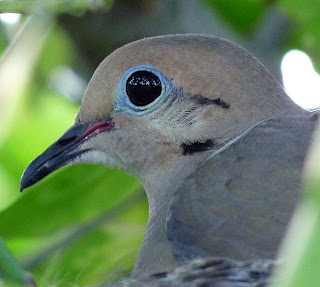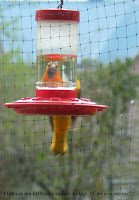
Yup, another White-winged Dove…the bird in the back with the white edges along the curve of its folded wing. Okay, very fast shot and through the window and some 60' away, to boot; but you can see it's what it is. Sweet!
This dove, like the one before, seems to hang with the Eurasian Collared Doves...which is, of course, why I suppose it's lonesome!
Also saw another Indigo Bunting today…but the several dozen cow-birds which showed up scared it off. Lordy, I do NOT like those cow-birds. To tell the truth, I'm thinking the bird was a hybrid...an Indigo/Lazuli cross. The intense blue bird had white wing-bars but it lacked the rufus breast-band but it had a white belly. I understand these two inter-breed where they overlap territories. Still...a stunning bird.
Monthly list of birds seen in my yard the month of May, 2009:
White-winged Dove, Mourning Dove, Cooper's Hawk, Baltimore Oriole, Indigo Bunting, Western Tanager, Great-tailed Grackle, Lesser Goldfinch (black-backed), Bullock's Oriole, Hairy Woodpecker, Sharp-shinned Hawk, Black-headed Grosbeak, Lazuli Bunting, Rose-breasted Grosbeak, Black-chinned Hummingbird, Broad-tailed Hummingbird, Brown-headed Cowbird, Common Grackle, Turkey Vulture, Evening Grosbeak, American Robin, American Crow, Red-winged Blackbird, Blue Jay, Common Raven, European Starling, Northern Flicker - Red-shafted, Downy Woodpecker, Black-headed Chickadee, Black-billed Magpie, House Sparrow, American Goldfinch, Pine Siskin, House Finch - red, yellow and orange variants, Eurasian Collared-Dove
 How humiliating…at first I thought I saw a light-eyed starling when I walked by the window. He seems to fly okay, but I hope he doesn’t have any migrating to do soon. A missing tail can’t be a good thing during long trips. I wonder if it will grow back.
How humiliating…at first I thought I saw a light-eyed starling when I walked by the window. He seems to fly okay, but I hope he doesn’t have any migrating to do soon. A missing tail can’t be a good thing during long trips. I wonder if it will grow back. What I am happy about is that while they’re still around, the Eurasian Collared Doves are not here in the great numbers they were…and have allowed the much smaller Mourning Doves to visit more often. The last few mornings I’ve seen as many as four at a time picking through the chicken scratch I toss in my yard. They make me smile. Have you ever seen one up close?
What I am happy about is that while they’re still around, the Eurasian Collared Doves are not here in the great numbers they were…and have allowed the much smaller Mourning Doves to visit more often. The last few mornings I’ve seen as many as four at a time picking through the chicken scratch I toss in my yard. They make me smile. Have you ever seen one up close?  And while dozens and dozens of Brown-headed cowbirds hang around, as well as two or three Red-winged blackbirds, I've not seen a Blue Jay in weeks. Even the woodpeckers, who do still show up, seem to be too busy to visit regularly. I rather like it that there are several Black-billed Magpies who drop in several times a day. They like the homemade suet I hang, even though feeding on those tiny little holders must feel a bit ungainly. Magpies and Grackles both seem to enjoy the kibble and peanuts-in-the-shell I put out for them, too. As I've said, I love the big guys...but they're the only ones my dog runs off. He does not like to share his marrow bones, even when he's already gotten all the marrow he can reach and chewed them down to nearly nothin. Funny dog...
And while dozens and dozens of Brown-headed cowbirds hang around, as well as two or three Red-winged blackbirds, I've not seen a Blue Jay in weeks. Even the woodpeckers, who do still show up, seem to be too busy to visit regularly. I rather like it that there are several Black-billed Magpies who drop in several times a day. They like the homemade suet I hang, even though feeding on those tiny little holders must feel a bit ungainly. Magpies and Grackles both seem to enjoy the kibble and peanuts-in-the-shell I put out for them, too. As I've said, I love the big guys...but they're the only ones my dog runs off. He does not like to share his marrow bones, even when he's already gotten all the marrow he can reach and chewed them down to nearly nothin. Funny dog...







.jpg)


.jpg)







.jpg)
.jpg)





